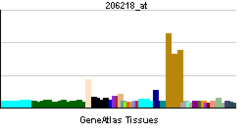MAGEB2
Melanoma-associated antigen B2 is a protein that in humans is encoded by the MAGEB2 gene.[3][4]
This gene is a member of the MAGEB gene family. The members of this family have their entire coding sequences located in the last exon, and the encoded proteins show 50 to 68% sequence identity to each other. The promoters and first exons of the MAGEB genes show considerable variability, suggesting that the existence of this gene family enables the same function to be expressed under different transcriptional controls. This gene is localized in the DSS (dosage-sensitive sex reversal) critical region. It is expressed in testis and placenta, and in a significant fraction of tumors of various histological types. The MAGEB genes are clustered on chromosome Xp22-p21.[4]
References
Further reading
- Maruyama K, Sugano S (1994). "Oligo-capping: a simple method to replace the cap structure of eukaryotic mRNAs with oligoribonucleotides.". Gene. 138 (1-2): 171–4. doi:10.1016/0378-1119(94)90802-8. PMID 8125298.
- Dabovic B, Zanaria E, Bardoni B, et al. (1996). "A family of rapidly evolving genes from the sex reversal critical region in Xp21.". Mamm. Genome. 6 (9): 571–80. doi:10.1007/BF00352360. PMID 8535061.
- Suzuki Y, Yoshitomo-Nakagawa K, Maruyama K, et al. (1997). "Construction and characterization of a full length-enriched and a 5'-end-enriched cDNA library.". Gene. 200 (1-2): 149–56. doi:10.1016/S0378-1119(97)00411-3. PMID 9373149.
- McCurdy DK, Tai LQ, Nguyen J, et al. (1998). "MAGE Xp-2: a member of the MAGE gene family isolated from an expression library using systemic lupus erythematosus sera.". Mol. Genet. Metab. 63 (1): 3–13. doi:10.1006/mgme.1997.2639. PMID 9538511.
- Lee JH, Sung BW, Youn HJ, Park JH (2001). "Identification, expression, and nuclear location of murine Mage-b2 protein, a tumor-associated antigen.". Mol. Cells. 10 (6): 647–53. doi:10.1007/s10059-000-0647-7. PMID 11211869.
- Park JH, Lee SW (2003). "Hypertonicity induction of melanoma antigen, a tumor-associated antigen.". Mol. Cells. 13 (2): 288–95. PMID 12018852.
- Strausberg RL, Feingold EA, Grouse LH, et al. (2003). "Generation and initial analysis of more than 15,000 full-length human and mouse cDNA sequences.". Proc. Natl. Acad. Sci. U.S.A. 99 (26): 16899–903. doi:10.1073/pnas.242603899. PMC 139241
 . PMID 12477932.
. PMID 12477932.
- Gerhard DS, Wagner L, Feingold EA, et al. (2004). "The status, quality, and expansion of the NIH full-length cDNA project: the Mammalian Gene Collection (MGC).". Genome Res. 14 (10B): 2121–7. doi:10.1101/gr.2596504. PMC 528928
 . PMID 15489334.
. PMID 15489334.
- Ross MT, Grafham DV, Coffey AJ, et al. (2005). "The DNA sequence of the human X chromosome.". Nature. 434 (7031): 325–37. doi:10.1038/nature03440. PMC 2665286
 . PMID 15772651.
. PMID 15772651.
- Milutinovic S, D'Alessio AC, Detich N, Szyf M (2007). "Valproate induces widespread epigenetic reprogramming which involves demethylation of specific genes.". Carcinogenesis. 28 (3): 560–71. doi:10.1093/carcin/bgl167. PMID 17012225.
- Ewing RM, Chu P, Elisma F, et al. (2007). "Large-scale mapping of human protein-protein interactions by mass spectrometry.". Mol. Syst. Biol. 3 (1): 89. doi:10.1038/msb4100134. PMC 1847948
 . PMID 17353931.
. PMID 17353931.

 . PMID 12477932.
. PMID 12477932. . PMID 15489334.
. PMID 15489334. . PMID 15772651.
. PMID 15772651. . PMID 17353931.
. PMID 17353931.